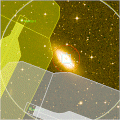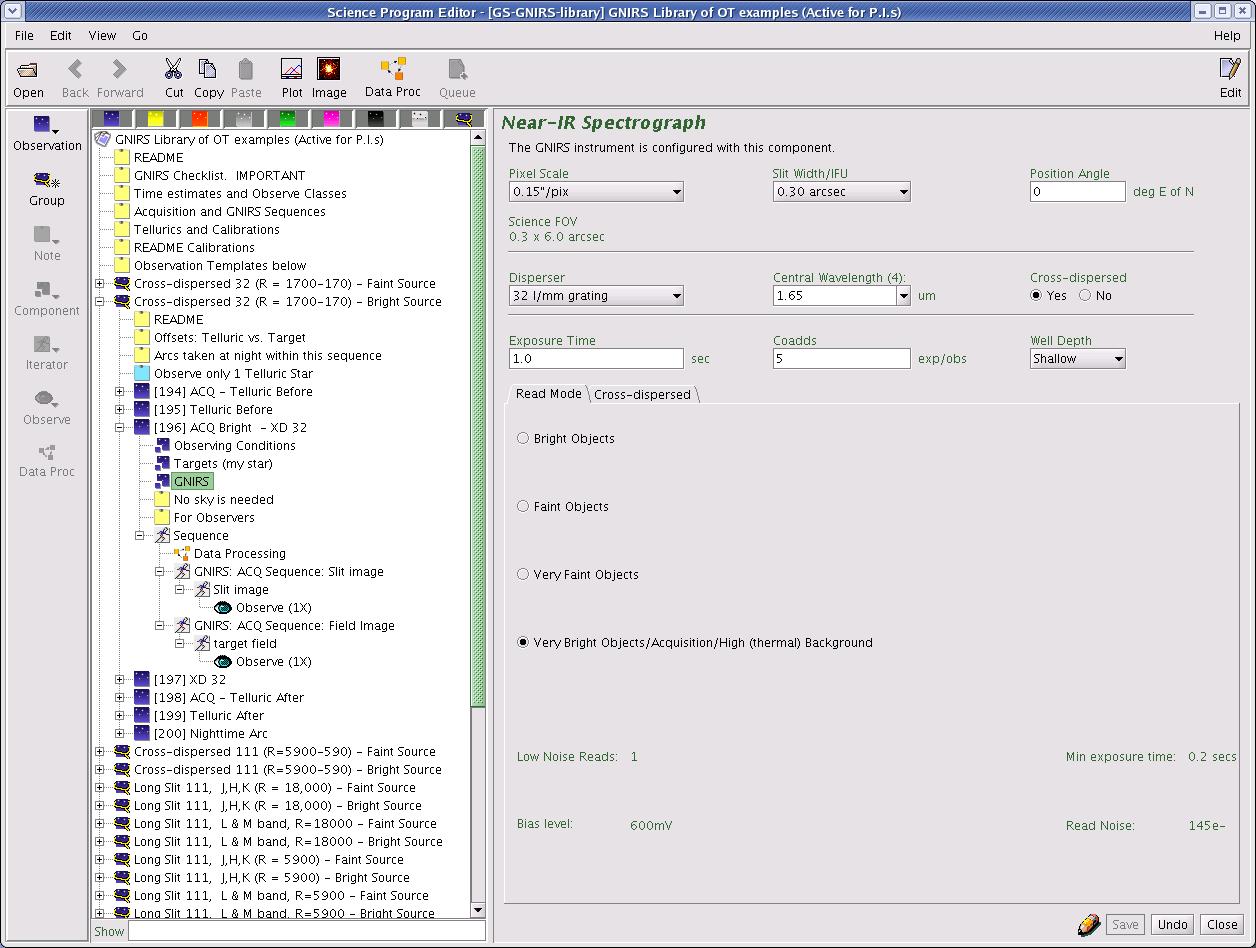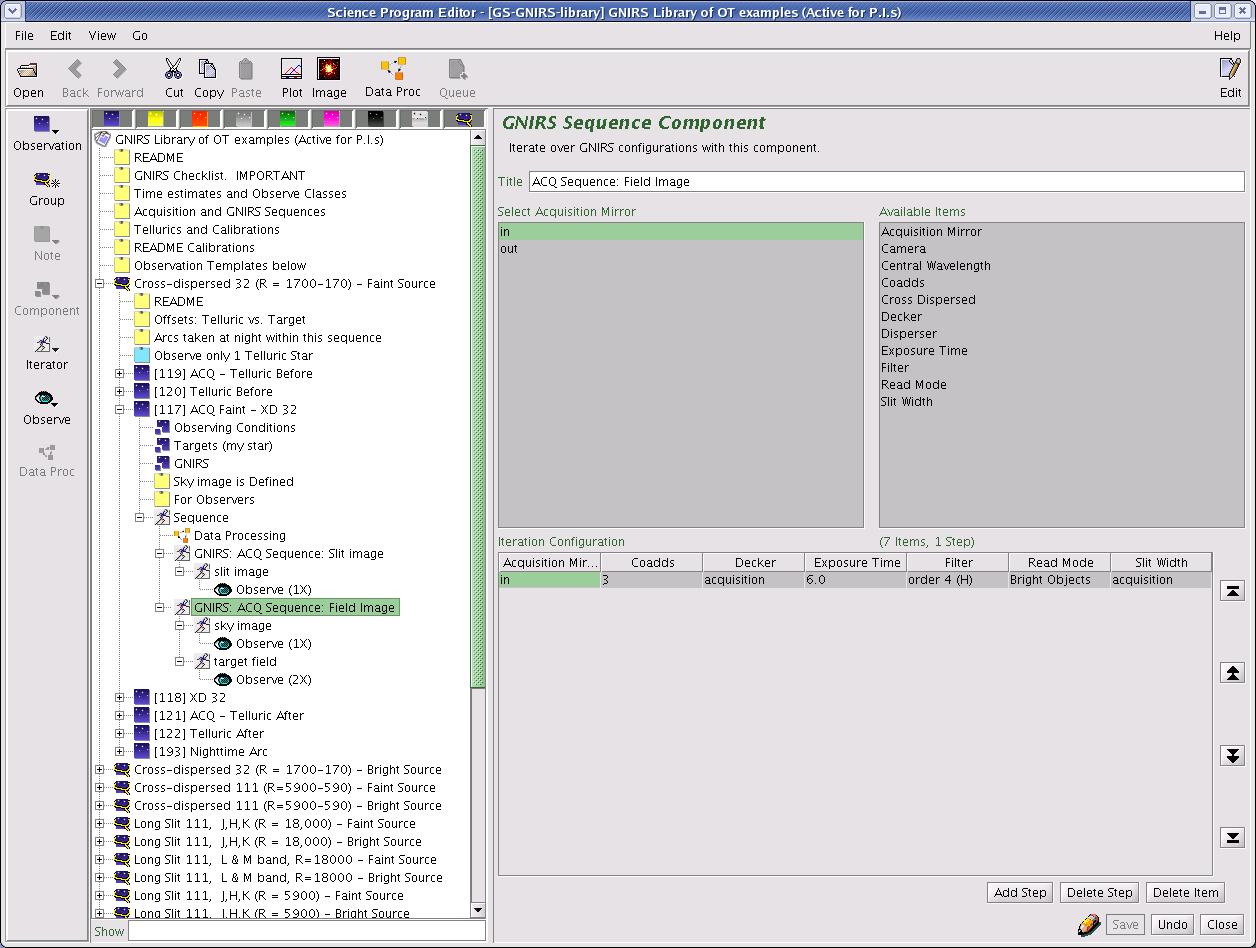
| You are in: Observing Tool (OT) > Science Program > Elements > OT Components and Iterators > OT GNIRS |

|
GNIRS in the Observing Tool |
It is recommended that you build your GNIRS observations using the OT library templates which provide sequences for all of the GNIRS instrument observing modes. Below is a guide to using the OT library, followed by detailed instructions on configuring GNIRS in the OT.
1) DECIDE on which GNIRS mode you need for your science. Consult the web pages for more information about the instrument capabilities that are offered.
2) CHOOSE whether you have a faint or bright science target. K = 14 is the boundary between the two cases.
3) SELECT the appropriate observation sequence (one of the blue groups) and paste this into your own phase II program. This is now your skeleton observation for a given science target at a given instrument configuration.
4) READ through all the notes in the group for more details about why the observations are set up as they are. Notice that in a scheduling group, the order of the observations defines the order in which they will be executed at the telescope.
5) UPDATE the target and GNIRS components (exposure time, coadds, position angle...) of all the science target and standard star observations within the group as necessary for your program and remove any unnecessary calibrations (e.g. J and H band cals for a K-band observation).
6) TELLURICS and other nighttime calibration observations are included within the group. End of night calibrations can be found within organizational folders (yellow) at the end of the GNIRS OT library. They should be kept separate from the nighttime science and calibration observations.
There are 2 recommended methods to organize your observations:
A) Group tellurics (2 sets per observation-- before/after) and calibrations with the science observation and corresponding acquisition observations. Rename the group to the name of the science target. This approach is best when there are multiple configurations, and/or few science targets. (see OT library example)
B) Define tellurics and calibrations separately, to be reused for all targets. This approach is better when there are numerous targets using the same calibrations or same set of tellurics. Baseline cals (including tellurics) DO NOT need to be repeated for every science target, however they must be at least 1 for each instrument configuration. IT MUST BE CLEAR WHICH CALIBRATIONS (tellurics and flats/arcs) GO WITH WHICH OBSERVATIONS.
Baseline telluric observations should be given Class ="Nighttime Partner Calibration" (at the "Observe" level); additional tellurics or other non-baseline nighttime observations should be given Class="Nighttime Program Calibration" (i.e., charged to program). All science observations (but not the acquisitions) have Class="Science".
There is also specific information on:
Note that the GNIRS
OIWFS is not yet available for use. However, the inner perimeter
of the OIWFS FOV in the Position editor is often useful to see the acquisition
imaging field of view.
For example templates of typical GNIRS Observations (i.e. science and telluric observations, all acquisitions, and GCAL calibrations), go to the instrument OT library.
More information and guidelines are available on the Observing Strategies
page. Highlights include:
Refer to the GNIRS instrument pages for general information about the instrument. When you're done, don't forget to check the Checklist. If you still have questions, submit a HelpDesk query.
The detailed component editor for GNIRS is accessed by adding a GNIRS component to an observation, or adding a "GNIRS Observation". The default screen looks like this:

The Wollaston prism is not yet available. All other items must be set (see below for more details). Briefly, these are:
When the "Cross-dispersed" buttons are set to "Yes", the cross-dispersed
tab becomes active (shown below). This tab displays the full wavelength
coverage provided by orders 3 through 8, the primary orders passed by the
cross-dispersing prism. (This is an informational tab only, no input
is required.) With pixel scale = 0.15 arcsec/pix and the 32 l/mm disperser
(max. R~1700), the central wavelength should be set to "cross-dispersed"
(=1.65um) and the observed spectrum provides essentially complete coverage
from 0.9 to 2.5 um.

Choice of camera (pixel scale), dispersing element and focal plane mask
(slit) is made by clicking on the pull down lists (i.e. the down-pointing
arrows) and selecting the desired item. There are 2 pixel scales in GNIRS;
0.15"/pixel is provided by the "short" cameras while 0.05"/pixel is provided
by the "long" cameras. With the 0.15" pixel scale, the 32 l/mm grating
(disperser) gives 2-pixel resolution of R~1700 (with the 0.3" slit) with complete
coverage of the J, H, or K bandpasses in single spectrum, while the
111 l/mm grating gives higher resolution (R~6000 in 2 pixels) with proportionally
less wavelength coverage. The 0.05" pixel scale increases these resolutions
by a factor of 3 (with a 0.1" slit), along with 3x the spatial resolution
(and the accompanying slit losses). The 10 l/mm grating reduces the
resolution a factor of 3 from the 32 l/mm grating and is not normally used.
A number of slit widths are available; slits wider than 2 pixels (0.3arcsec
or 0.1arcsec with the long cameras) will reduce the effective resolution.
The slit length is determined separately and is fixed by the mode
(99" for long slit with 0.15"/pix; 49" for long slit with 0.05"/pix; 6.1"
for XD). The science field of view (shown in green) will update to
reflect the configuration chosen, also displayed by the position editor.
To define an IFU observation, set slit width = IFU. The IFU can
only be used with the 0.15/pix scale, and not in cross-dispersed mode of
course. Other items can be configured as desired. Because the
IFU provides a 2-dimensional FOV, the offset sequences can offset in p
and q. See the IFU page
for more information.
To use the highest (spatial or spectral) resolution, select the 0.05"/pix pixel scale. For R~18000, this pixel scale must be combined with the 111 l/mm grating.
The central wavelengths for each band when using the 32 l/mm disperser with the 0.15 arcsec pixel scale (R~1700; including cross-dispersed) are provided as a menu in the "central wavelength" window; it is strongly recommended that the menu wavelengths be used for this configuration. For R~6000 and 18000, one can also enter a specific wavelength in this window. The number in parentheses to the right of "Central Wavelength" indicates the order associated with that wavelength. Note that the proper order-sorting filter is automatically selected based on the central wavelength. When "Cross-dispersed" is set to "Yes", the Cross-dispersed tab will show the wavelength coverage provided by all the orders available in the cross-dispersed mode.
The exposure time is set by clicking in the relevant window and typing
the required number of seconds. Each occurrence of the observe element will cause N
exposures to be taken and coadded in the instrument control system. The
value of N is set by typing an integer in the "coadds" window.
The total exposure in each output image will be the exposure times the number
of coadds. Each observe element has a "Class" associated with it,
primarily for time-accounting and proprietary data purposes. These
classes are described here.
The facility Cassegrain Rotator can rotate the instrument to any desired angle. The angle (in conventional astronomical notation of degrees east of north) is set by typing in the "position angle" window. The view of the science field in the position editor will reflect the selected angle. Alternatively the angle may be set or adjusted in the position editor itself by interactively rotating the science field.
There are several read modes for different kinds of observations (see GNIRS Detector page). Defining
the exposure time will automatically set the array read mode. The array
bias voltage can also be set for "deep well" and "shallow well." The choice
of bias voltage affects the well depth, but not the minimum integration time
or read noise. Note that changes to bias can not be made within the sequencer--
to change from shallow well (<2.5um) to deep well (LM), please define
separate observations.
The save button accepts the latest changes and stores the program
to the local database (this is done automatically
when one changes windows and in certain other conditions), the undo/redo
button (and, transiently, the edit pencil) toggles pending
and saved changes and the close button closes the science program
editor (saving any changes to the local database). To make the changes
visible in the observing database used by the observatory, the program must
be stored.
The GNIRS Iterator is a member of a class of instrument iterators. Each works
exactly the same way, except that different options are presented depending
upon the instrument. The GNIRS iterator is most commonly used to step through
different wavelengths. A number of items are available in the iterator
that would NOT commonly be used in a science observation. The typical
items that would be used are

Set up an iteration sequence by building an Iteration Table. The
table columns are items over which to iterate. In this example we are
iterating over wavelengths, exposure time and coadds. Table rows correspond
to iterator steps. At run time, all the values in a row are set at once.
Since there are two steps in this table, an observe element nested inside
the GNIRS iterator would produce an observe command for each of the two wavelengths,
using the specified integration times. Note that every dark gray line
is a step-- blank dark grey lines retain the values from preceding steps.
GNIRS iterators are only required when the observation is stepping through different GNIRS configurations. If you are iterating on GNIRS configurations and also dithering, the offset iterator would normally be nested inside the GNIRS iterator, and the observe command nested inside the offset iterator. To repeat a dither pattern at each configuration, the repeat iterator must come between the GNIRS iterator and the offset iterator. In the example above, the sequence repeats the dither pattern ("Obj-Sky") 3 times for each wavelength, taking 1 exposure at each dither position. See the science program structure for more details about nested iterators.
A good way to check your observing sequence is by clicking on the "Sequence"
folder. There one can view the sequence as a contiguous list of actions
or as a timeline.
The offset iterator is a general iterator, common to all instruments. With this iterator one can define the offset sequence to use for dithering on the sky. Most infrared observations use some type of dithering to facilitate sky subtraction. Typical examples are ABBA (two positions along the slit), and object-sky (on-source and off-source). When using the long slit, the slit length is 99 arcsec, so one can dither along the slit at multiple positions for a point source (e.g., ABCDE), or use an ABBA sequence even for moderately extended objects. However, in cross-dispersed mode, the slit is only 6.1 arcseconds in length. For point sources, an ABBA sequence with a separation of 2.5-3.0 arcseconds will work; if a larger separation is required, an on-source/off-source (object-sky) sequence will be needed. A separation of 2 arcseconds is possible if very good image quality (<0.5arcsecs) has been requested. Refer to the Observing Strategies page for more on dithering techniques. When defining offsets, remember that "q" is along the slit (or IFU slice) and "p" is perpendicular to the slit (or IFU slice), always (regardless of instrument orientation). One can check the offset positions with the position editor.
Acquisition is defined in a separate observation from the science observation.
This is done to prevent inadvertent changes to the science observation.
Here we describe the mechanics of creating an acquisition observation in
the OT. Appropriate acquisition exposure times are tabulated here. The GNIRS acquistion
field scale and orientation is shown here. The acquisition procedure
is described more generally on the Observing Strategies
page.
The best method is to make a copy of your science observation and replace
the sequence portion with an acquisition sequence (leaving target and other
instrument information unchanged). The recommended procedure is the
following.


PIs are required to specify all calibrations, including baseline calibrations,
in their Phase II OT file. For baseline calibrations, this means "before"
and "after" telluric standards and GCAL flats and arcs. These observations
may be executed within the program or from a "general use" calibration program,
but in either case will be charged as baseline. Calibrations in addition to
the baseline set will be charged to the program, unless they can be executed
in the afternoon (e.g., darks, twilight flats). See the Baseline Calibrations
and Observing Strategies pages for more information. GNIRS flats and arcs
are taken with the Gemini Calibration unit (GCAL). Flats and arcs that are
taken with the data (i.e., without changing the instrument configuration)
can be embedded inside the science or telluric observation. The "Observe Class"must be set properly
to ensure that the time accounting and proprietary period for baseline calibrations
are handled correctly. Calibration observations that are not executed
within the science program, such as cross-dispersed flats, should be defined
as separate observations that are executed separately from the science observations
(these have Observe Class = "Daytime Calibration"). XD flats must be
executed at the end of the night; IFU flats must be taken with the science
data; all other flats can be taken separately or with the data, at the PI's
discretion (see the GNIRS
GCAL configurations page for more information.)
The OT calibration library
includes typical GCAL calibrations for most common configurations. Duplicate
copies of calibration observations are not required, but there must be one
observation for each instrument configuration requested. Exposure times
and proper GCAL lamps/filters may need to be adjusted from the examples depending
on the wavelength and slit width being used. Proper GCAL/GNIRS configurations
are available.
Telluric standards should be defined as a normal science observation would be-- including an acquisition observation and the desired offset sequence. The only difference is the "Observe Class" which should be set to "Nighttime Partner Calibration" for baseline standards, or "Nighttime Program Calibration" for special/additional calibrations.
See Observing Strategies pages for more information.Last update August 30, 2006; G. Doppmann